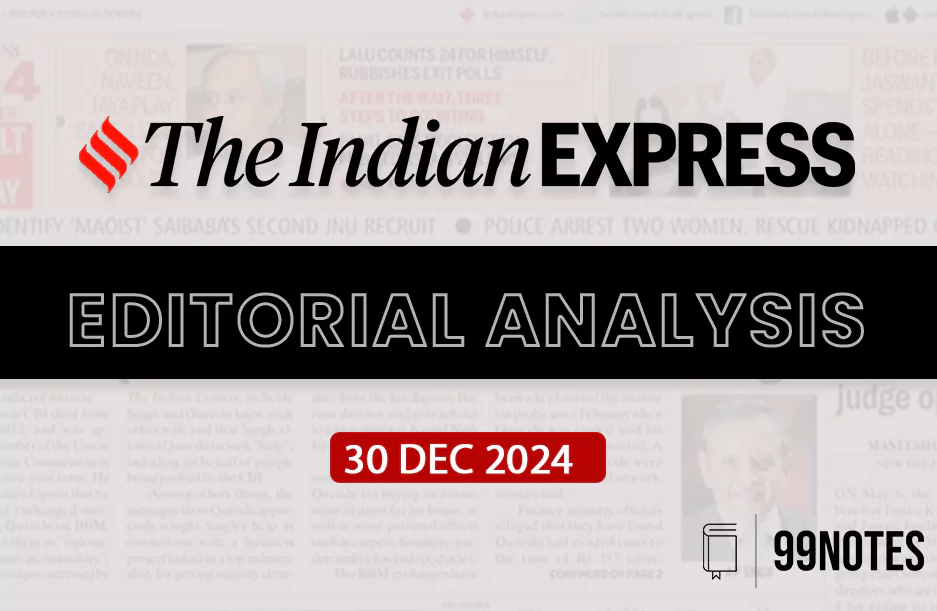30 December 2024 : Indian Express Editorial Analysis
1. Paradigm shift without shocks
(Source – Indian Express, Section – The ideas page, Page No. – 11)
| Topic: GS3 – Indian Economy |
| Context |
| The article highlights Dr. Manmohan Singh’s pivotal role in transforming India’s economy through visionary reforms and leadership, balancing growth with equity while navigating economic challenges. |
A Visionary Leader: Manmohan Singh’s Transformative Legacy
- Dr. Manmohan Singh is widely recognized as one of India’s most capable prime ministers.
- His tenure as Finance Minister in the Narasimha Rao government marked a turning point in the Indian economy.
- The economic reforms he championed required a rare combination of vision and courage.
- These changes dismantled rigid controls, redefined the role of the state, and integrated India into the global economy.
- As Prime Minister, Dr. Singh displayed similar foresight, making India a significant voice on the world stage.
A Long Association and Shared Contributions
- The author’s association with Dr. Singh dates back to the late 1960s, highlighting a shared journey through key roles in the Indian economy.
- During the economic crisis of the 1990s, their collaboration was pivotal.
- As the Reserve Bank of India’s governor, the author worked closely with Dr. Singh to navigate the challenges of reform.
- These frank exchanges of ideas fostered a mutual understanding that laid the groundwork for fundamental shifts in India’s economic trajectory.
The Three Pillars of Economic Reform
- The 1990s reforms, often referred to as a paradigm shift, rested on three pillars: dismantling the control and permit regime, redefining the state’s role, and embracing global trade.
- These measures transformed India from an insular economy into a competitive, outward-looking nation.
- The foreign exchange system was revamped, culminating in a market-determined exchange rate in 1993, a change managed smoothly to avoid shocks.
- Banking reforms introduced competition and reduced the government’s share in public sector banks to 51%, signaling a shift in economic philosophy.
Fiscal and Trade Reforms: A Balancing Act
- Fiscal reforms were central to restoring economic stability. Containing the fiscal deficit, a root cause of the 1990 crisis, was a top priority.
- This required balancing trade policy adjustments, such as lowering import duties, with tax reforms that widened the tax base.
- The Fiscal Responsibility and Budget Management Act formalized the commitment to reducing the deficit.
- These efforts underpinned India’s impressive growth trajectory, with real GDP growth exceeding 9% during Dr. Singh’s prime ministerial tenure from 2005-06 to 2007-08.
A Shift in Economic Philosophy
- Dr. Singh’s journey from an advocate of centralized planning to a proponent of liberalized reforms underscores his ability to adapt.
- While prioritizing efficiency and growth, he remained committed to equity. Initiatives like the Rural Employment Guarantee Scheme and the National Food Security Act exemplified his concern for the vulnerable.
- Contrary to criticisms, Dr. Singh integrated growth with equity, ensuring that reforms benefitted all sections of society.
A Man of Ideas and Implementation
- Dr. Singh’s dual strengths in intellectual rigor and execution came to the fore during his leadership in challenging times.
- His humility and courtesy further distinguished him as a statesman. The foundations he laid in 1991 were instrumental in positioning India on the path to becoming a developed nation.
- His legacy is a testament to his ability to balance growth with equity, vision with implementation, and economic progress with social responsibility.
Today, as discussions about India’s future as a developed nation by 2047 abound, Dr. Singh’s contributions remain a cornerstone of this aspiration.
| Practice Question: Discuss the role of Dr. Manmohan Singh in shaping India’s economic reforms of the 1990s. How did his vision and policies balance economic growth with equity and inclusion? (150 Words /10 marks) |



